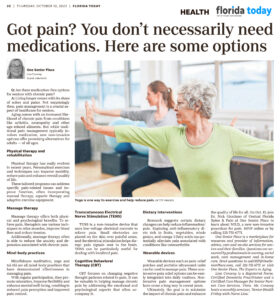

Lisa Conway – FLORIDA TODAY
Q: Are there medication-free options for seniors with chronic pain?
 A: Living longer comes with its share of aches and pains. Not surprisingly then, pain management is a crucial aspect of healthcare for seniors. Aging comes with an increased likelihood of chronic pain from conditions like arthritis, neuropathy and other age-related ailments. But while traditional pain management typically involves medication, new non-invasive options offer promising alternatives for adults– of all ages.
A: Living longer comes with its share of aches and pains. Not surprisingly then, pain management is a crucial aspect of healthcare for seniors. Aging comes with an increased likelihood of chronic pain from conditions like arthritis, neuropathy and other age-related ailments. But while traditional pain management typically involves medication, new non-invasive options offer promising alternatives for adults– of all ages.
Physical Therapy and Rehabilitation
Physical therapy has really evolved in recent years. Personalized exercises and techniques can improve mobility, reduce pain, and enhance overall quality of life. These tailored programs can address specific pain-related issues and improve function, often incorporating manual therapy, aquatic therapy and adaptive exercise equipment.
Massage Therapy
Massage therapy offers both physical and psychological benefits. To relieve pain, therapists use various techniques to relax muscles, improve blood flow and reduce tension. Additionally, massage therapy often is able to reduce the anxiety and depression associated with chronic pain.
Mind-Body Practices
Mindfulness meditation, yoga, and tai chi are all mind-body practices that have demonstrated effectiveness in managing pain. With regular participation, they promote relaxation, improve flexibility and enhance mental well-being, resulting in reduced pain perception and improved pain control.
Transcutaneous Electrical Nerve Stimulation (TENS)
TENS is a non-invasive device that uses low-voltage electrical currents to relieve pain. Small electrodes are placed on the skin over painful areas, and the electrical stimulation helps disrupt pain signals sent to the brain. TENS can be particularly useful for dealing with localized pain.
Cognitive Behavioral Therapy (CBT)
CBT focuses on changing negative thought patterns related to pain. It can be valuable in helping manage chronic pain by addressing the emotional and psychological aspects that often accompany it.
Dietary Interventions
Research suggests certain dietary changes can help reduce inflammation/pain. Exploring anti-inflammatory diets rich in fruits, vegetables, whole grains, and omega-3 fatty acids can potentially alleviate pain associated with conditions like osteoarthritis.
Wearable Devices
Wearable devices such as pain-relief patches and portable ultrasound units can be used to conveniently manage pain. These non-invasive pain relief options can be easily integrated into daily routines.
Non-invasive pain management options have come a long way in recent years. Ultimately, the goal is to minimize the impact of chronic pain and enhance the quality of life for all. On October 13, join Dr. Nick Giordano of Central Florida Spine & Pain at One Senior Place to learn about MILD, a new non-invasive procedure for pain. RSVP online or by calling 321-751-6771.
One Senior Place is a marketplace for resources and provider of information, advice, care and on-site services for seniors and their families. Questions for this column are answered by professionals in nursing, social work, care management and in-home care. Send questions to askOSP@OneSeniorPlace.com, call 321-751-6771 or visit One Senior Place, The Experts in Aging.
Lisa Conway is a Registered Nurse and a Certified Care Manager for Senior Partner Care Services, Viera.


